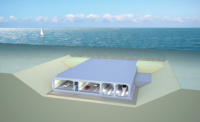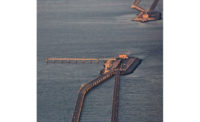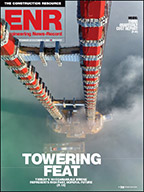Longest Immersed-Tube Tunnels






























































Immersed-tube tunnels are rare birds. Only a handful are under construction in the world each year. They consist of large tubes, constructed in sections often more than 100 meters in length, which are floated into position in a waterway, sunk into position, and joined with watertight seals. They are always placed in a trench on the bottom of the river or bay. They are constructed of steel or reinforced concrete. [Slideshow: The 10 Longest Immersed-Tube Tunnels]
“While bridges are generally cheaper to build, immersed-tube tunnels are usually located at sites where bridges would not be possible. Either soil conditions are poor, or there is constricted space on the sides of the waterway, or there is a high clearance required for navigation by ships,” says Jonathan Baber, a project director for Mott MacDonald, and co-author of “Immersed Tunnels.”
In certain conditions, immersed-tube tunnels can be a less expensive choice. “If you are crossing a river between a half km to one km wide, an immersed tube will probably be competitive price-wise compared to bore tunnels, because of the procurement cost of a tunnel boring machine,” explains Baber.
The first immersed-tube tunnel was a sewer tunnel built in Boston in 1894. The Michigan Central Railway Tunnel linking Detroit with Windsor, Ontario, Canada, under the Detroit River, was the first immersed-tube vehicular tunnel, when it was completed in 1910. The first immersed-tube tunnel in Europe was the Maastunnel, a road tunnel in Rotterdam that opened in 1942.
The Dutch are probably the most prolific builders of immersed-tube tunnels. “Their flat, delta-type landscape and soft, peaty soils are ideally suited for immersed-tube tunnels,” says Baber, who also serves as animateur (chairman) of the International Tunnelling Association’s working group for immersed tunnels.
The Busan-Geoje tunnel in South Korea is a project whose challenging conditions spurred several new approaches. Strukton Immersion Projects, a Dutch firm, serving as a subcontractor, was responsible for the flotation, transportation, and immersion of the tunnel sections.
“The most challenging conditions were the swell waves. They influenced the immersion,” says Peter van Westendorp, project manager with Strukton, who served as the immersion commander on the project. “We used two purpose-built pontoons and four tugboats to transport the tunnel sections 32 km from the casting yard to the site. We had to travel by night. It took us 10 hours. The second night we would do the immersion, which took 16 hours each time.”
“Our model tests showed that during the positioning of each element on the seabed the elements were still being moved by the currents. So we developed the external positioning system in order to set down the elements at a safe distance from each other in the bottom of the trench. We then jacked up each element, using 800-ton jacks located in the legs of the external positioning system, and moved the element forward by winching.”
Another precedent for Strukton was their decision to use a submarine. “By doing immersion at that great a depth, the exit shaft had to be extremely rigid, which was not practical. We had all kinds of equipment inside the tunnel, which were remotely controlled, such as cameras to watch the bulkheads inside the tunnel, and level gauges to measure ballast tank level. If the systems had failed we would have had to go inside the tunnel sections, so we put technicians in the submarine. But the systems worked, so we did not have to use the submarine for real.”
More recently Strukton has worked on an immersed-tube tunnel in Amsterdam. The project involves building a new metro station beneath the central train station, and a new metro line under the I J river.
A new immersed-tube record breaking tunnel is currently taking shape in China. The Hong Kong-Zhuhai-Macao Bridge is a 50-km long link consisting of three cable-stayed bridges, two artificial islands, and a 6.7 km long immersed tube which will be the world’s longest immersed tube, when it is completed in 2016.
A tunnel between Germany and Denmark that is currently in the design stage is expected to be the new world record holder when it is completed in 2021. The Fehmarn Belt Fixed Link is a proposed 18 km long immersed-tube tunnel between Fehmarn Island in Germany and Lolland Island in Denmark, that will carry both a highway and rail line. It will significantly cut the current travel time between Hamburg and Copenhagen. It is expected to cost $7 billion to build.
Femern A/S, the project owner, has prequalified nine large contractor consortia to bid for the four major contracts (northbound tube, southbound tube, portals and ramps, and dredging and land reclamation). Preliminary bids are expected to be submitted in 2014, with construction beginning in 2015.



































